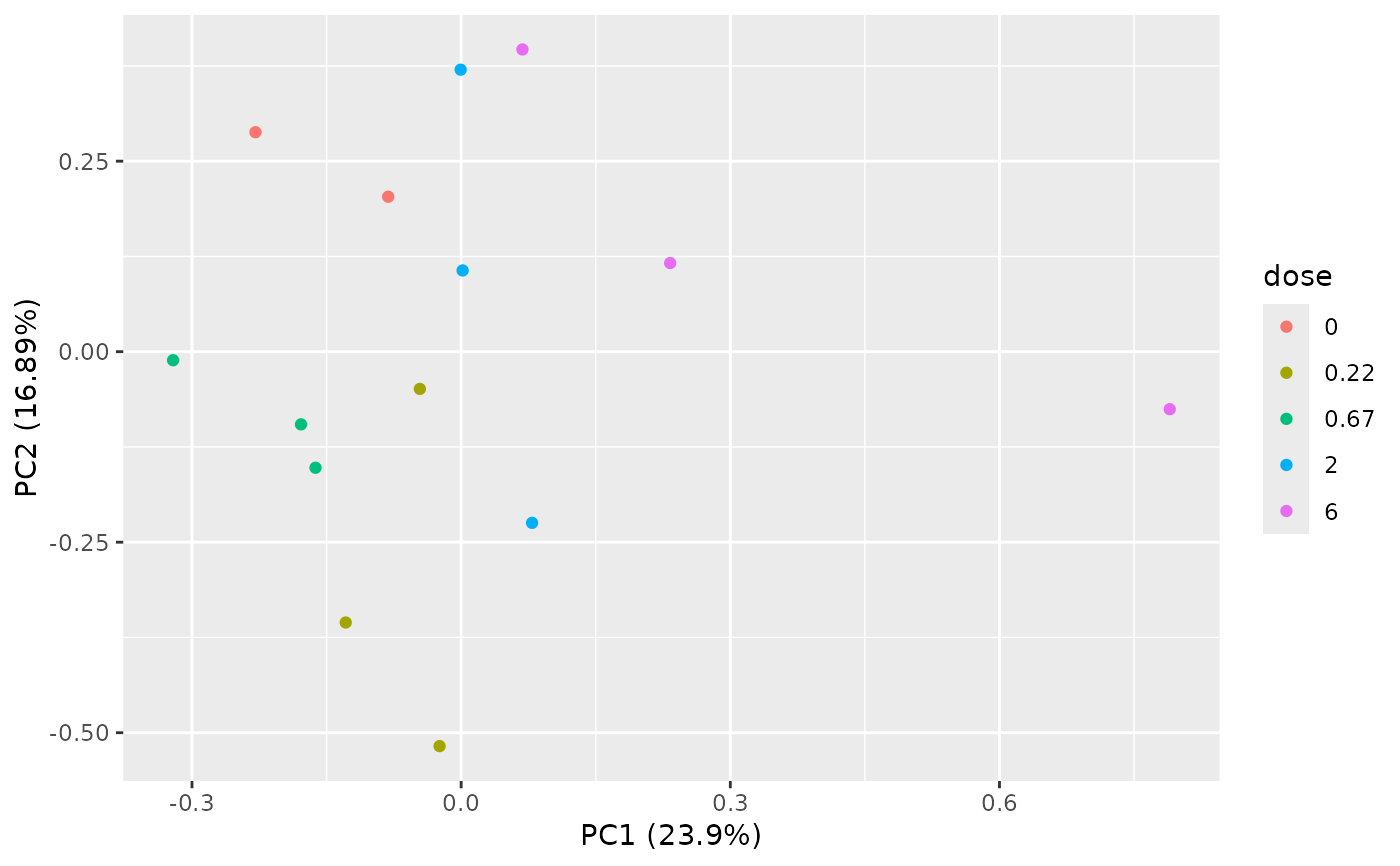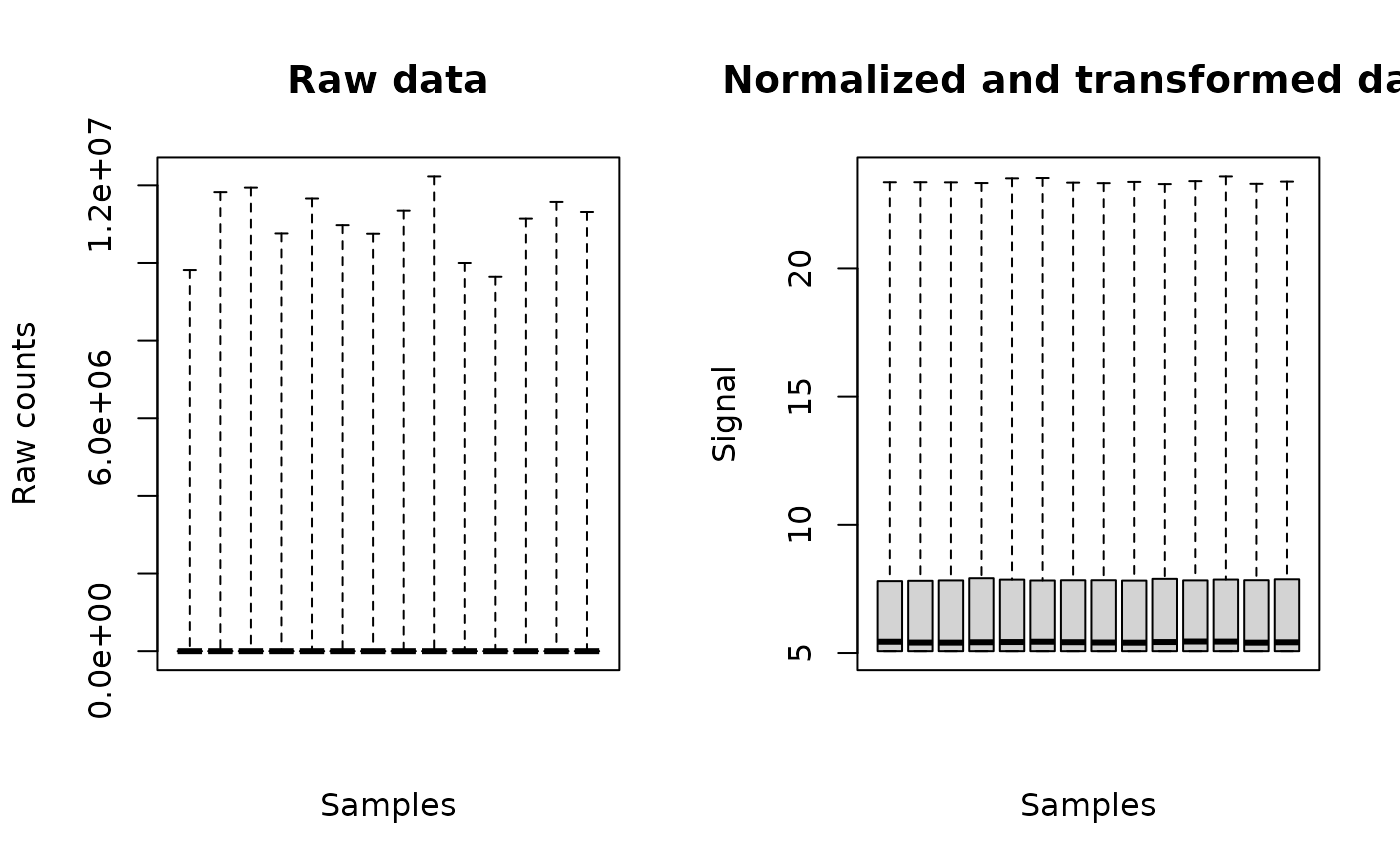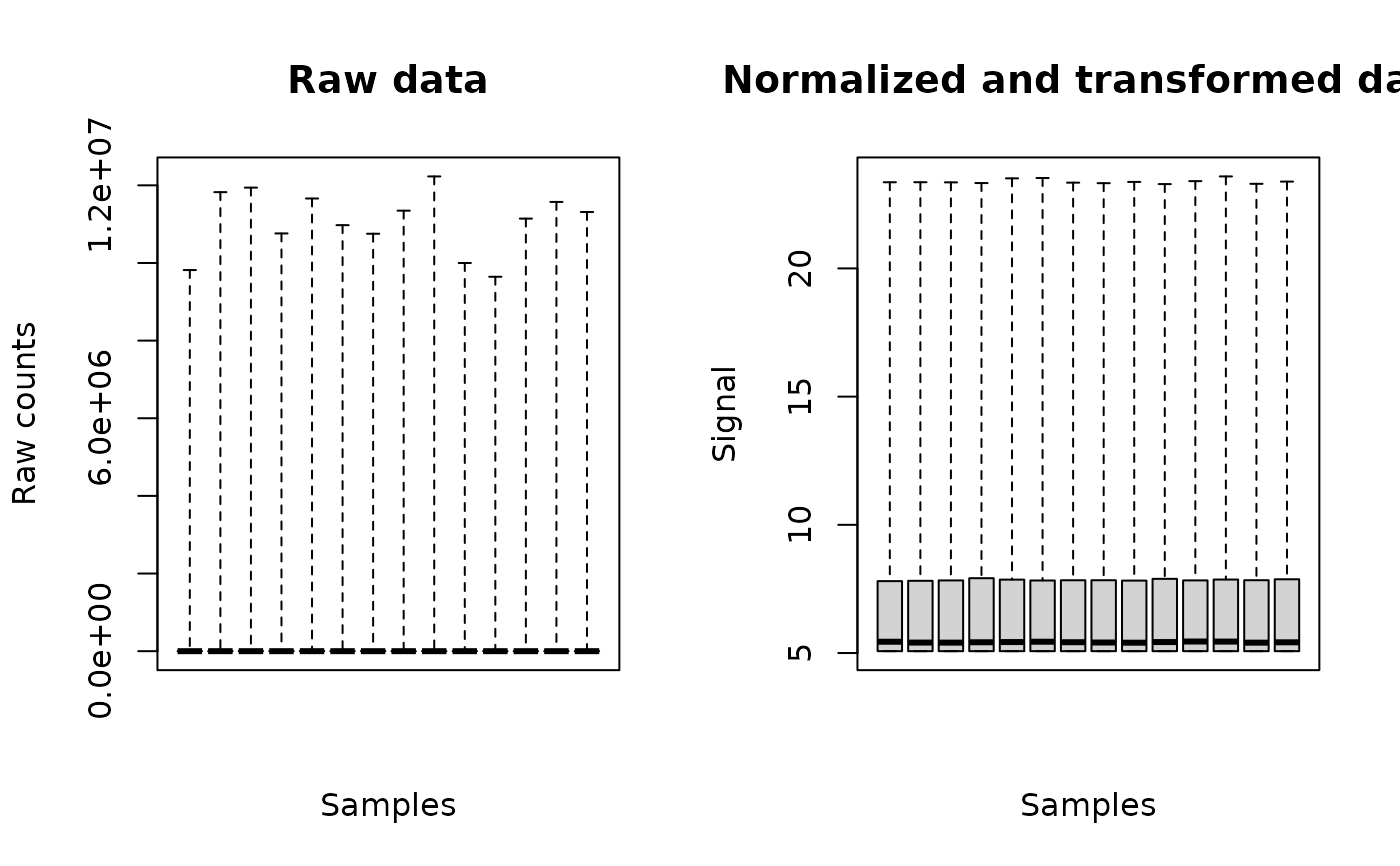Import, check and normalization and transformation of RNAseq data
RNAseqdata.RdRNAseq data in raw counts (integer values) are imported from a .txt file
(internally imported using the function read.table),
checked or from a R object of class data.frame
(see the description
of argument file for the required format
of data),
normalized with respect to library size and tranformed in
a log2 scale using
variance stabilizing transformation or regularized logarithm.
Arguments
- file
The name of the .txt file (e.g.
"mydata.txt") containing one row per item, with the first column corresponding to the identifier of each item, and the other columns giving the responses of the item for each replicate at each dose or concentration. In the first line, after a name for the identifier column, we must have the tested doses or concentrations in a numeric format for the corresponding replicate (for example, if there are triplicates for each treatment, the first line could be "item", 0, 0, 0, 0.1, 0.1, 0.1, etc.). This file is imported within the function using the functionread.tablewith its default field separator (sep argument) and its default decimal separator (dec argument at "."). Alternatively an R object of classdata.framecan be directly given in input, corresponding to the output ofread.table(file, header = FALSE)on a file described as above. The two alternatives are illustrated below in examples.- backgrounddose
This argument must be used when there is no dose at zero in the data, to prevent the calculation of the BMD by extrapolation. All doses below or equal to the value given in backgrounddose will be fixed at 0, so as to be considered at the background level of exposition.
- check
If TRUE the format of the input file is checked.
- transfo.method
The method chosen to transform raw counts in a log2 scale using the
DESeq2:"rlog"for regularized logarithm or"vst"for variance stabilizing transformation. If missing, default value defined at"rlog"for datasets with less than 30 samples and at"vst"if not- transfo.blind
Argument given to function
rlogorvst, seerlogandvstfor an explaination, by default atTRUEas in theDESeq2package .- round.counts
Put it to TRUE if your counts come from Kallisto or Salmon in order to round them before treatment with
DESeq2.- x
An object of class
"RNAseqdata".- range4boxplot
An argument passed to boxplot(), fixed by default at 0 to prevent the producing of very large plot files due to many outliers. Can be put at 1.5 to obtain more classical boxplots.
- ...
further arguments passed to print or plot functions.
Details
This function imports the data, checks their format (see the description
of argument file for the required format
of data) and gives in the print information
that should help the user to check that the coding of data is correct : the tested doses (or concentrations)
the number of replicates for each dose, the number of items, the identifiers
of the first 20 items. Data are normalized with respect to library size
and tranformed using functions rlog or vst of the
DESeq2 package depending on the specified method : "rlog"
(recommended default choice) or
"vst".
Value
RNAseqdata returns an object of class "RNAseqdata", a list with 9 components:
- data
the numeric matrix of normalized and transformed responses of each item in each replicate (one line per item, one column per replicate)
- dose
the numeric vector of the tested doses or concentrations corresponding to each column of data
- item
the character vector of the identifiers of the items, corresponding to each line of data
- design
a table with the experimental design (tested doses and number of replicates for each dose) for control by the user
- data.mean
the numeric matrix of mean responses of each item per dose (mean of the corresponding replicates) (one line per item, one column per unique value of the dose)
- data.sd
the numeric matrix of standard deviations of the response of each item per dose (sd of the corresponding replicates, NA if no replicate) (one line per item, one column per unique value of the dose)
- transfo.method
The transformation method specified in input
- raw.counts
the numeric matrix of non transformed responses (raw counts) of each item in each replicate (one line per item, one column per replicate) before normalization
- containsNA
always at FALSE as RNAseq data are not allowed to contain NA values
The print of a RNAseqdata object gives the tested doses (or concentrations)
and number of replicates for each dose, the number of items, the identifiers
of the first 20 items (for check of good coding of data) and the tranformation method.
The plot of a RNAseqdata object shows the data distribution for each dose or concentration and replicate before and after normalization and tranformation.
See also
See read.table the function used to import data,
rlog and vst for details about the
transformation methods and
microarraydata, continuousomicdata and
continuousanchoringdata for other types of data.
References
Love MI, Huber W, and Anders S (2014), Moderated estimation of fold change and dispersion for RNA-seq data with DESeq2. Genome biology, 15(12), 550.
Examples
# (1) import, check, normalization and transformation of RNAseq data
# An example on a subsample of a data set published by Zhou et al. 2017
# Effect on mouse kidney transcriptomes of tetrachloroethylene
# (see ? Zhou for details)
#
datafilename <- system.file("extdata", "RNAseq_sample.txt", package="DRomics")
(o <- RNAseqdata(datafilename, check = TRUE, transfo.method = "vst"))
#> converting counts to integer mode
#> Warning:
#> To optimize the dose-response modelling, it is recommended to use a
#> dose-response design with at least six different tested doses.
#> Elements of the experimental design in order to check the coding of the data:
#> Tested doses and number of replicates for each dose:
#>
#> 0 0.22 0.67 2 6
#> 2 3 3 3 3
#> Number of items: 999
#> Identifiers of the first 20 items:
#> [1] "NM_144958" "NR_102758" "NM_172405" "NM_029777" "NM_001130188"
#> [6] "NM_207141" "NM_001162368" "NM_008117" "NM_001168290" "NM_010910"
#> [11] "NM_001004147" "NM_001146318" "NM_145597" "NM_001161797" "NM_021483"
#> [16] "NR_002862" "NR_033520" "NM_134027" "NM_010381" "NM_019388"
#> Data were normalized with respect to library size and tranformed using
#> the following method: vst
plot(o)
 # If you want to use your own data set just replace datafilename,
# the first argument of RNAseqdata(),
# by the name of your data file (e.g. "mydata.txt")
#
# You should take care that the field separator of this data file is one
# of the default field separators recognised by the read.table() function
# when it is used with its default field separator (sep argument)
# Tabs are recommended.
# Use of an R object of class data.frame
# below the same example taking a subsample of the data set
# Zhou_kidney_pce (see ?Zhou for details)
data(Zhou_kidney_pce)
subsample <- Zhou_kidney_pce[1:1000, ]
(o <- RNAseqdata(subsample, check = TRUE, transfo.method = "vst"))
#> converting counts to integer mode
#> Warning:
#> To optimize the dose-response modelling, it is recommended to use a
#> dose-response design with at least six different tested doses.
#> Elements of the experimental design in order to check the coding of the data:
#> Tested doses and number of replicates for each dose:
#>
#> 0 0.22 0.67 2 6
#> 2 3 3 3 3
#> Number of items: 999
#> Identifiers of the first 20 items:
#> [1] "NM_144958" "NR_102758" "NM_172405" "NM_029777" "NM_001130188"
#> [6] "NM_207141" "NM_001162368" "NM_008117" "NM_001168290" "NM_010910"
#> [11] "NM_001004147" "NM_001146318" "NM_145597" "NM_001161797" "NM_021483"
#> [16] "NR_002862" "NR_033520" "NM_134027" "NM_010381" "NM_019388"
#> Data were normalized with respect to library size and tranformed using
#> the following method: vst
plot(o)
# If you want to use your own data set just replace datafilename,
# the first argument of RNAseqdata(),
# by the name of your data file (e.g. "mydata.txt")
#
# You should take care that the field separator of this data file is one
# of the default field separators recognised by the read.table() function
# when it is used with its default field separator (sep argument)
# Tabs are recommended.
# Use of an R object of class data.frame
# below the same example taking a subsample of the data set
# Zhou_kidney_pce (see ?Zhou for details)
data(Zhou_kidney_pce)
subsample <- Zhou_kidney_pce[1:1000, ]
(o <- RNAseqdata(subsample, check = TRUE, transfo.method = "vst"))
#> converting counts to integer mode
#> Warning:
#> To optimize the dose-response modelling, it is recommended to use a
#> dose-response design with at least six different tested doses.
#> Elements of the experimental design in order to check the coding of the data:
#> Tested doses and number of replicates for each dose:
#>
#> 0 0.22 0.67 2 6
#> 2 3 3 3 3
#> Number of items: 999
#> Identifiers of the first 20 items:
#> [1] "NM_144958" "NR_102758" "NM_172405" "NM_029777" "NM_001130188"
#> [6] "NM_207141" "NM_001162368" "NM_008117" "NM_001168290" "NM_010910"
#> [11] "NM_001004147" "NM_001146318" "NM_145597" "NM_001161797" "NM_021483"
#> [16] "NR_002862" "NR_033520" "NM_134027" "NM_010381" "NM_019388"
#> Data were normalized with respect to library size and tranformed using
#> the following method: vst
plot(o)
 PCAdataplot(o)
PCAdataplot(o)
 # (2) transformation with two methods on the whole data set
# \donttest{
data(Zhou_kidney_pce)
# variance stabilizing tranformation
(o1 <- RNAseqdata(Zhou_kidney_pce, check = TRUE, transfo.method = "vst"))
#> converting counts to integer mode
#> Warning:
#> To optimize the dose-response modelling, it is recommended to use a
#> dose-response design with at least six different tested doses.
#> Elements of the experimental design in order to check the coding of the data:
#> Tested doses and number of replicates for each dose:
#>
#> 0 0.22 0.67 2 6
#> 2 3 3 3 3
#> Number of items: 33394
#> Identifiers of the first 20 items:
#> [1] "NM_144958" "NR_102758" "NM_172405" "NM_029777" "NM_001130188"
#> [6] "NM_207141" "NM_001162368" "NM_008117" "NM_001168290" "NM_010910"
#> [11] "NM_001004147" "NM_001146318" "NM_145597" "NM_001161797" "NM_021483"
#> [16] "NR_002862" "NR_033520" "NM_134027" "NM_010381" "NM_019388"
#> Data were normalized with respect to library size and tranformed using
#> the following method: vst
plot(o1)
# (2) transformation with two methods on the whole data set
# \donttest{
data(Zhou_kidney_pce)
# variance stabilizing tranformation
(o1 <- RNAseqdata(Zhou_kidney_pce, check = TRUE, transfo.method = "vst"))
#> converting counts to integer mode
#> Warning:
#> To optimize the dose-response modelling, it is recommended to use a
#> dose-response design with at least six different tested doses.
#> Elements of the experimental design in order to check the coding of the data:
#> Tested doses and number of replicates for each dose:
#>
#> 0 0.22 0.67 2 6
#> 2 3 3 3 3
#> Number of items: 33394
#> Identifiers of the first 20 items:
#> [1] "NM_144958" "NR_102758" "NM_172405" "NM_029777" "NM_001130188"
#> [6] "NM_207141" "NM_001162368" "NM_008117" "NM_001168290" "NM_010910"
#> [11] "NM_001004147" "NM_001146318" "NM_145597" "NM_001161797" "NM_021483"
#> [16] "NR_002862" "NR_033520" "NM_134027" "NM_010381" "NM_019388"
#> Data were normalized with respect to library size and tranformed using
#> the following method: vst
plot(o1)
 # regularized logarithm
(o2 <- RNAseqdata(Zhou_kidney_pce, check = TRUE, transfo.method = "rlog"))
#> Just wait, the transformation using regularized logarithm (rlog) may
#> take a few minutes.
#> converting counts to integer mode
#> Warning:
#> To optimize the dose-response modelling, it is recommended to use a
#> dose-response design with at least six different tested doses.
#> Elements of the experimental design in order to check the coding of the data:
#> Tested doses and number of replicates for each dose:
#>
#> 0 0.22 0.67 2 6
#> 2 3 3 3 3
#> Number of items: 33394
#> Identifiers of the first 20 items:
#> [1] "NM_144958" "NR_102758" "NM_172405" "NM_029777" "NM_001130188"
#> [6] "NM_207141" "NM_001162368" "NM_008117" "NM_001168290" "NM_010910"
#> [11] "NM_001004147" "NM_001146318" "NM_145597" "NM_001161797" "NM_021483"
#> [16] "NR_002862" "NR_033520" "NM_134027" "NM_010381" "NM_019388"
#> Data were normalized with respect to library size and tranformed using
#> the following method: rlog
plot(o2)
# regularized logarithm
(o2 <- RNAseqdata(Zhou_kidney_pce, check = TRUE, transfo.method = "rlog"))
#> Just wait, the transformation using regularized logarithm (rlog) may
#> take a few minutes.
#> converting counts to integer mode
#> Warning:
#> To optimize the dose-response modelling, it is recommended to use a
#> dose-response design with at least six different tested doses.
#> Elements of the experimental design in order to check the coding of the data:
#> Tested doses and number of replicates for each dose:
#>
#> 0 0.22 0.67 2 6
#> 2 3 3 3 3
#> Number of items: 33394
#> Identifiers of the first 20 items:
#> [1] "NM_144958" "NR_102758" "NM_172405" "NM_029777" "NM_001130188"
#> [6] "NM_207141" "NM_001162368" "NM_008117" "NM_001168290" "NM_010910"
#> [11] "NM_001004147" "NM_001146318" "NM_145597" "NM_001161797" "NM_021483"
#> [16] "NR_002862" "NR_033520" "NM_134027" "NM_010381" "NM_019388"
#> Data were normalized with respect to library size and tranformed using
#> the following method: rlog
plot(o2)
 # variance stabilizing tranformation (blind to the experimental design)
(o3 <- RNAseqdata(Zhou_kidney_pce, check = TRUE, transfo.method = "vst",
transfo.blind = TRUE))
#> converting counts to integer mode
#> Warning:
#> To optimize the dose-response modelling, it is recommended to use a
#> dose-response design with at least six different tested doses.
#> Elements of the experimental design in order to check the coding of the data:
#> Tested doses and number of replicates for each dose:
#>
#> 0 0.22 0.67 2 6
#> 2 3 3 3 3
#> Number of items: 33394
#> Identifiers of the first 20 items:
#> [1] "NM_144958" "NR_102758" "NM_172405" "NM_029777" "NM_001130188"
#> [6] "NM_207141" "NM_001162368" "NM_008117" "NM_001168290" "NM_010910"
#> [11] "NM_001004147" "NM_001146318" "NM_145597" "NM_001161797" "NM_021483"
#> [16] "NR_002862" "NR_033520" "NM_134027" "NM_010381" "NM_019388"
#> Data were normalized with respect to library size and tranformed using
#> the following method: vst
plot(o3)
# variance stabilizing tranformation (blind to the experimental design)
(o3 <- RNAseqdata(Zhou_kidney_pce, check = TRUE, transfo.method = "vst",
transfo.blind = TRUE))
#> converting counts to integer mode
#> Warning:
#> To optimize the dose-response modelling, it is recommended to use a
#> dose-response design with at least six different tested doses.
#> Elements of the experimental design in order to check the coding of the data:
#> Tested doses and number of replicates for each dose:
#>
#> 0 0.22 0.67 2 6
#> 2 3 3 3 3
#> Number of items: 33394
#> Identifiers of the first 20 items:
#> [1] "NM_144958" "NR_102758" "NM_172405" "NM_029777" "NM_001130188"
#> [6] "NM_207141" "NM_001162368" "NM_008117" "NM_001168290" "NM_010910"
#> [11] "NM_001004147" "NM_001146318" "NM_145597" "NM_001161797" "NM_021483"
#> [16] "NR_002862" "NR_033520" "NM_134027" "NM_010381" "NM_019388"
#> Data were normalized with respect to library size and tranformed using
#> the following method: vst
plot(o3)
 # regularized logarithm
(o4 <- RNAseqdata(Zhou_kidney_pce, check = TRUE, transfo.method = "rlog",
transfo.blind = TRUE))
#> Just wait, the transformation using regularized logarithm (rlog) may
#> take a few minutes.
#> converting counts to integer mode
#> Warning:
#> To optimize the dose-response modelling, it is recommended to use a
#> dose-response design with at least six different tested doses.
#> Elements of the experimental design in order to check the coding of the data:
#> Tested doses and number of replicates for each dose:
#>
#> 0 0.22 0.67 2 6
#> 2 3 3 3 3
#> Number of items: 33394
#> Identifiers of the first 20 items:
#> [1] "NM_144958" "NR_102758" "NM_172405" "NM_029777" "NM_001130188"
#> [6] "NM_207141" "NM_001162368" "NM_008117" "NM_001168290" "NM_010910"
#> [11] "NM_001004147" "NM_001146318" "NM_145597" "NM_001161797" "NM_021483"
#> [16] "NR_002862" "NR_033520" "NM_134027" "NM_010381" "NM_019388"
#> Data were normalized with respect to library size and tranformed using
#> the following method: rlog
plot(o4)
# regularized logarithm
(o4 <- RNAseqdata(Zhou_kidney_pce, check = TRUE, transfo.method = "rlog",
transfo.blind = TRUE))
#> Just wait, the transformation using regularized logarithm (rlog) may
#> take a few minutes.
#> converting counts to integer mode
#> Warning:
#> To optimize the dose-response modelling, it is recommended to use a
#> dose-response design with at least six different tested doses.
#> Elements of the experimental design in order to check the coding of the data:
#> Tested doses and number of replicates for each dose:
#>
#> 0 0.22 0.67 2 6
#> 2 3 3 3 3
#> Number of items: 33394
#> Identifiers of the first 20 items:
#> [1] "NM_144958" "NR_102758" "NM_172405" "NM_029777" "NM_001130188"
#> [6] "NM_207141" "NM_001162368" "NM_008117" "NM_001168290" "NM_010910"
#> [11] "NM_001004147" "NM_001146318" "NM_145597" "NM_001161797" "NM_021483"
#> [16] "NR_002862" "NR_033520" "NM_134027" "NM_010381" "NM_019388"
#> Data were normalized with respect to library size and tranformed using
#> the following method: rlog
plot(o4)
 # }
# }